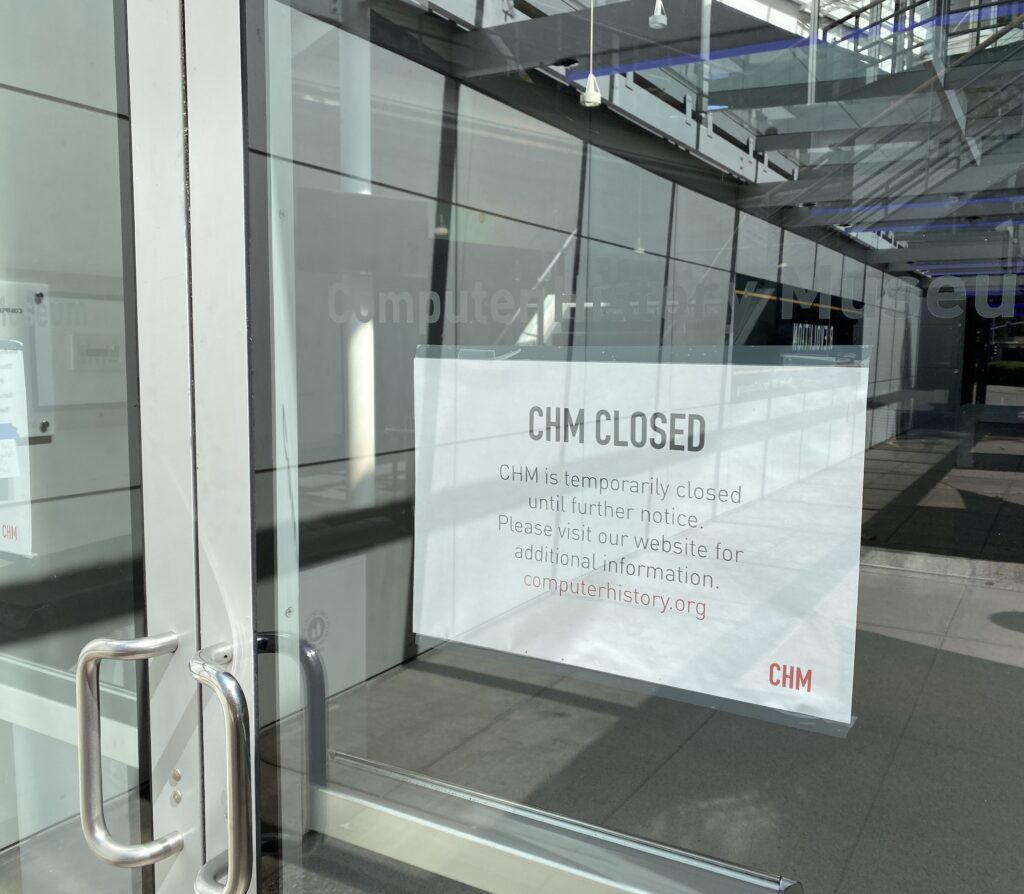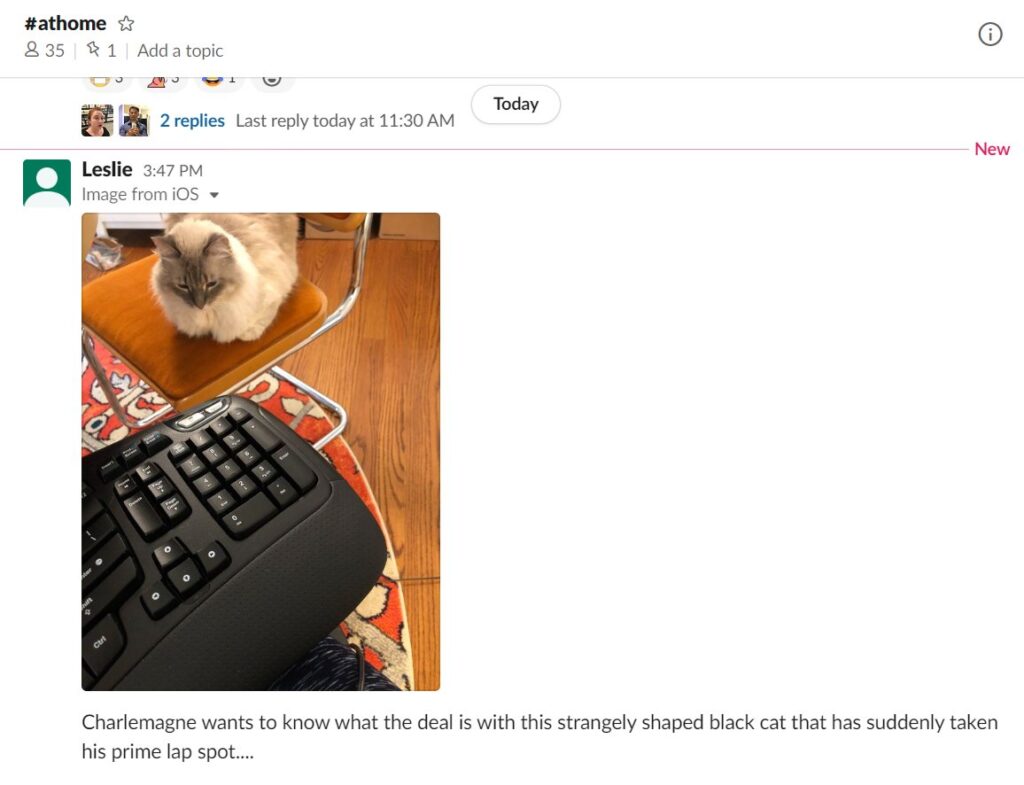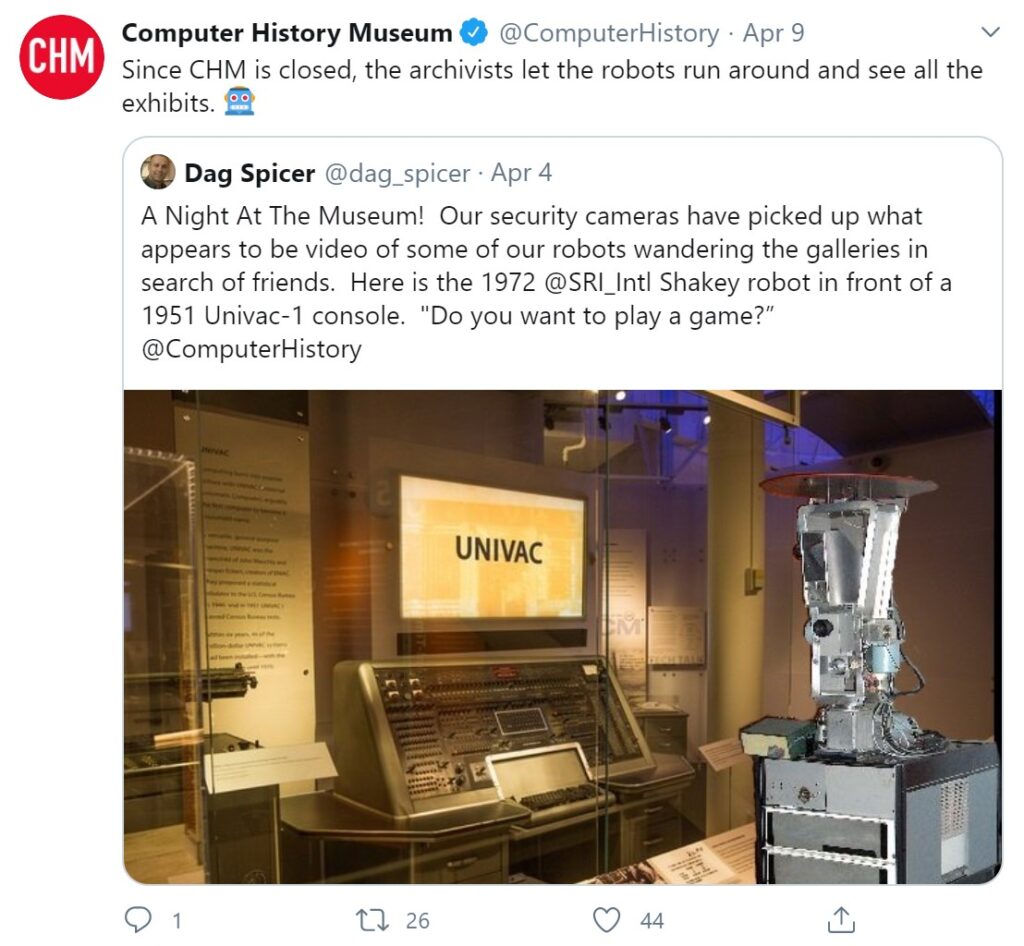
Marissa Mayer said, “Creativity loves constraint.” That was never more true than in this moment in time.
Monday, March 16, 2020, started like any other day at the Museum: staff and volunteers welcomed visitors to our exhibits and behind-the-scenes employees were busy planning the next event, developing content, archiving the collection, or working on museum operations. The executive staff was gathered for a weekly meeting, discussing the potential unfolding impact of COVID-19 when we received notification that Santa Clara County was implementing a “shelter-in-place” directive effective Tuesday, March 17 at 12:01 a.m.

In the midst of change, we found ways to be creative and adapt and, as a result, have become more open than ever! Our new digital front door—our website—has allowed us to reimagine the museum experience, including how we host events, share activities and resources, and provide access to exhibits and tours.
That day the Museum staff made the transition from our place-based office life to working from home. Looking back, the entire effort was a balance of teamwork, community support, new tools at the right time, and most importantly digging deep to find a new level of stamina and creativity.
In normal times, the museum field is very welcoming and supportive. Museum professionals often reach out to each other to share ideas or pick each other's brains. And during the early days of the pandemic it was no different. Just three days after the shelter-in-place order, Bay Area museum CEOs and directors set-up a weekly zoom call to share information, strategy, and operational plans. Discussions ranged from finances and the Payroll Protection Plan to new digital strategies; how to recoup lost revenue to how to create virtual education or gala events; what to do about summer camps to how to care for and feed the animals in zoos and aquariums. Three things really struck me about these conversations: a deep commitment to mission, a desire to serve audiences no matter what, and a “staff first” mindset as we worked to create a collaborative and supportive virtual work environment. In some ways the weekly group meeting felt like therapy.
This year’s American Association of Museums (AAM) all-virtual meeting was themed “Radical Reimaging." It focused on the role of museums during these unprecedented times and how museums can learn from each other. Panel topics included everything from fundraising and board governance to storytelling and diversity.
Within the CHM community, we made communication a priority. The executive staff met daily to check in with each other and their teams, which now continues three times a week. The CEO wrote the board of trustees “weekend updates” on Fridays. We implemented virtual all-hands meetings while departments set-up regular check-ins. We launched a popular #athome channel on Slack (a messaging app) so that staff could share their working-from-home highs and lows but generally to make each other laugh.

CHM's #athome channel on Slack has become the place for sharing recipes, gardening hacks, pets, and more!
The marketing team sent updates to volunteers and members. And, the development team reached out to museum members, wishing them and their families well and letting them know how the Museum was doing. First and foremost, the health and safety of our staff, volunteers, members, and visitors were our top priority.
From an operations standpoint, because CHM was deemed a “Nonessential Business,” as defined by the state, most of the staff, volunteers, and contractors have vacated the premises to work from home. A small team continues to work on-site to monitor the safety and security of our building and collections. We are also proactively working through scenarios both short and longer term to prepare for the pandemic’s effects on the local economy and cultural and business environments. The CHM finance team deserves high praise for securing the Payroll Protection Plan for CHM, allowing staff to stay employed as long as possible. Unfortunately some Bay Area museums have not fared as well. For all of the local and national museums, the goal has been to preserve staff and uphold mission as long as possible in hopes of weathering the storm and returning intact and, if possible, even stronger. We sincerely hope to open our doors as soon as it is safe.
It also turned out that our decision to improve the Museum’s digital infrastructure about a year ago really paid off during the current crisis. First, the Museum launched a new website in fall 2019 with significantly improved functionality, allowing us to build and publish digital content more quickly and to re-package our online content for an “at home” audience.

Check out all of CHM’s virtual activities and resources, perfect for at-home learning. Our resources introduce technological and historical concepts in creative and engaging ways for learners of all ages.
Second, the IT team relocated services like our helpdesk, office drives, collaboration tools, etc. to the cloud, allowing them to continue to remotely support staff with minimal interruption. We were also in the middle of an institution-wide upgrade of our donor and customer systems service systems to Salesforce. Shelter-in-place gave staff the opportunity to focus on this ambitious project, and staff who normally worked at the front desk and store were able to participate in the migration and quality control. And last but not least, the Museum was fortunate to have received a donation of new laptops from Microsoft. This was big news for the staff, as some of us had been working on 10-year-old laptops. With some long days and careful planning, the IT team configured and delivered laptops in the final hours on our last day at the Museum. It was truly a remarkable morale booster to leave the mothership and face an unknown world with a new laptop, a lifeline to each other.
And then there is Zoom. The amazing, exhausting platform we are living in day to day. For the Museum, mastering Zoom has become a critical priority in order to engage our audiences through our popular speakers series, CHM Live. Just three weeks after shelter-in-place, we pivoted from in-person events to virtual events—first on April 27 with Microsoft CTO Kevin Scott on the growing digital divide between rural and urban America and then on May 18 with Affectiva CEO Rana el Kaliouby on emotional AI. And while we are still discovering the mysteries of Zoom, our media team is well on its way to Zoom mastery, not just for upcoming events but also for our oral history program. We are shipping pop-up kits complete with a lighting solution (lighting is everything, they say), external microphone, and camera to achieve the highest quality possible given the circumstances. These are all skills that will serve us well in the long run, as they will allow us to collect and tell more stories than ever before. And you can’t beat the endless possibilities of self-expression with those Zoom backgrounds.

Even though our all-staff meetings and museum happy hours may look a little different, our HR staff has made sure that CHMers still feel a sense of community.
The education team is also adjusting to the “new normal” and exploring how to reach youth through a digital first strategy. Pilots and prototypes are underway to virtualize our workshops and work with partners with distribution platforms. The team is thinking out of the box (literally) and exploring how to create programs that not only have a positive impact on human lives but also bring a smile on their faces. In March, our team re-organized our website to make accessible activities and resources for our at-home audiences, including a popular virtual tour of Revolution, videos and lesson plans for families and adults as well as a new virtual version of our family-oriented Revolution scavenger hunt, which has been very successful with over 1,500 visits in just four months.
You might wonder how the collections team, whose daily work is to care for the world’s largest collection of computing artifacts, archives, and historical software, might do their job from home. The answer is one part timing and three parts creativity. The team was in the final months of a federally funded collection processing grant and was able to complete the work by meticulously transporting remaining items home to process while also finalizing finding aids and reports. Much to the group’s surprise they found remote work freeing in terms of thinking through new ways to work together, not unlike moving into a new empty house and experimenting with solutions you never thought possible in the old space. The team is actively exploring new tools like Airtable, a collaboration app that consolidates multiple spreadsheets and databases in the cloud, and has already used it to put the collections disaster plan into the cloud, create tracking and sorting views for our 1,000+ oral history collection, and respond to research requests more expediently. They’ve even found themselves having fun on CHM’s social media.

CHM’s collection and curatorial teams have found a new way to share our exhibits with everyone via social media, enlisting the help of a very special and on-the-loose host: Shakey the Robot.
Finally the team has put together plans and funding proposals for the Museum’s new initiative OpenCHM, which includes making CHM’s collection more accessible and searchable online by cataloging the collection in innovative ways and expanding the use of digital tools to aid in search, retrieval, and the creation of mini-galleries on the fly. We want to open up the collection to scholars at the intersection of digital technologies and humanities as well as to the public itself to use the collection for research and creative projects.
I don’t want to paint too rosy a picture because it has been very challenging for everyone. Balancing work and parenting. Worrying about our family nearby or far away that we can’t visit. We are all working longer hours both to get the work done and to reimagine and implement a new kind of museum. We miss our colleagues, our work spaces, our collections, our exhibits, our programs, our visitors, our trustees, and our members.

CHM Staff celebrates the opening of its new Learning Lab in 2019.
We miss all these things we have built together over the course of time. But these cherished spaces, objects, and people are not gone; they are merely in suspended animation. For now we must turn our attention to the digital world and new ways of thinking. It’s an opportunity, really. And we are embracing it. It's a mindset shift that is fitting for a museum that explores how technology can shape a better future. And some time, in that beautiful future we are all longing for, we will bring together our physical treasures and our shiny new digital world and be a better museum for it. Special thanks to our hard working staff, dedicated volunteers and trustees, museum colleagues and members and donors and those we have lost. Thank you all for your camaraderie and support.
CHM Live | Reprogramming The American Dream with Microsoft CTO Kevin Scott, April 27, 2020. Read the recap.
CHM Live | Girl Decoded: Rana el Kaliouby in Conversation with NPR Contributor Aarti Shahani, May 18, 2020. Read the recap.
CHM Live | Maintenance and invention: Lessons from Hubble. Kathryn Sullivan in Conversation with CHM’s David C. Brock, June 24, 2020. Read the recap.
Missed an event? Check out our CHM Live recaps.